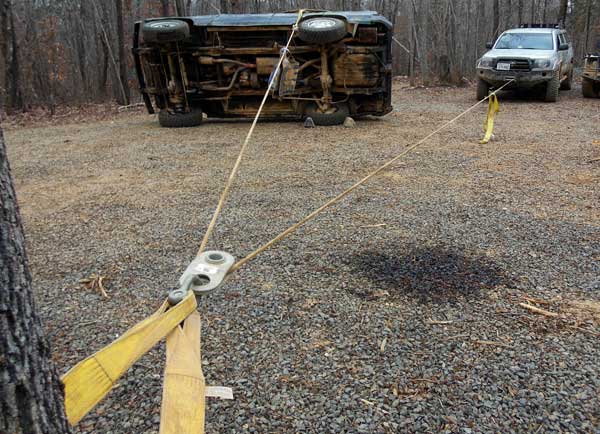
Preparing for an expedition that covers potentially dodgy desert terrain, it is important to be ready for anything — including the possibility that a vehicle rolls over. In the case of an actual rollover, priority is getting people safely cleared from the vehicle and attending to any serious medical injuries. Once we’ve made sure the ignition is turned off and verified that everyone is OK, we need to determine if the vehicle in a precarious position, such as possibly falling off a cliff, and if so, secure it with straps, before occupants exit. When extracting occupants, if the vehicle is completely upside down, make sure that each person is braced before cutting the seatbelt, or they will fall headfirst. If the vehicle is on its side, get the person on top out first. (If someone has a neck or back injury, wait for professional emergency services to remove the injured person so as not to risk spinal injury.)
After people are secure, we would move on to the problem of righting the vehicle. Garrett Porterfield of Overland Experts walked us through the steps of uprighting a toppled Landrover at their training facility in Virginia. The first thing to do is take the time to properly assess the situation. Visualize how strap placement and direction of pull will affect the way the vehicle moves. Consider the terrain and any potential difficulties it might add to the recovery scenario.
In this exercise, we were working on the premise that the Landrover tipped on a sidehill of some sort, and that we couldn’t bring the recovery vehicle around to the other side. We would have to run the line to it using a “snatch block,” a specially designed pulley that could reverse the direction of the pull.
Before winching, make sure to set the emergency brake and put the vehicle in park or in gear so that it will not roll once back on its wheels. It is also a good idea to chock a wheel. Clear any debris and ensure the recovery area is clear of bystanders.
As we ran the winch, the Landrover slowly began tipping back in the right direction. A final creak, and the clunk of the tires bouncing into place, and we were done. In real life, we would be averting disaster.
Debris from the demonstration vehicle littered the ground, highlighting the importance of having everything properly tied down at all times. There were also pools of fluids that had dripped out. Once the vehicle is upright, check the damage. Make sure the battery hasn’t come off its mount. Check the fluid levels and top off as necessary. Check the cooling system to ensure the radiator is not leaking (if it is, you will need radiator stop leak to get moving). When you go to start the vehicle back up, bump the starter a couple times listening to the sound of the engine. If it seems to spin freely you should be ok but if you sense any kind of resistance, stop. It is possible that oil or fuel has filled the cylinders. You will need to remove the spark plugs and spin the engine with the starter to evacuate any fluid to prevent hydrolocking the engine.
In “real life” we would need to effectuate the recovery process as quickly as possible. But of course, in “real life” we’d do best not to topple over in the first place.